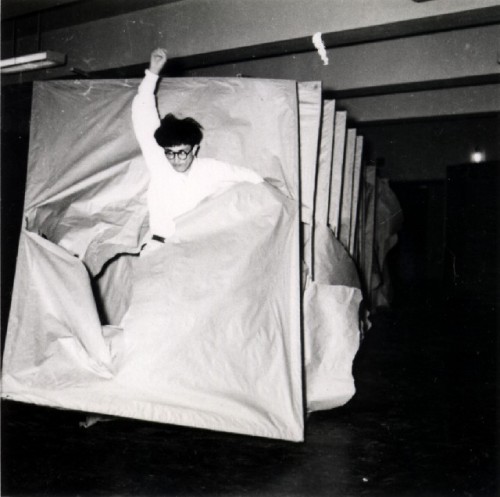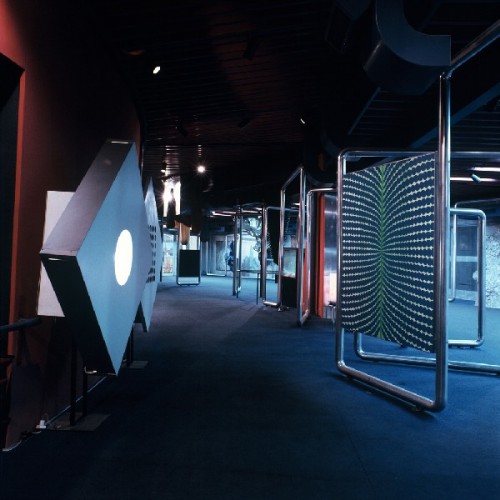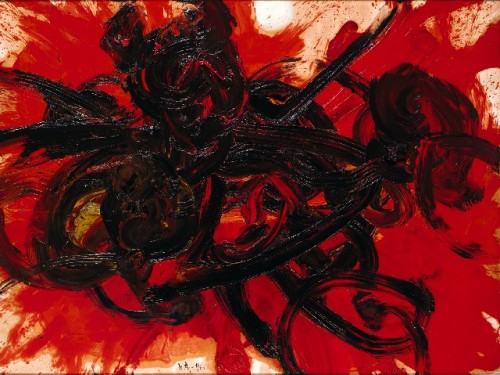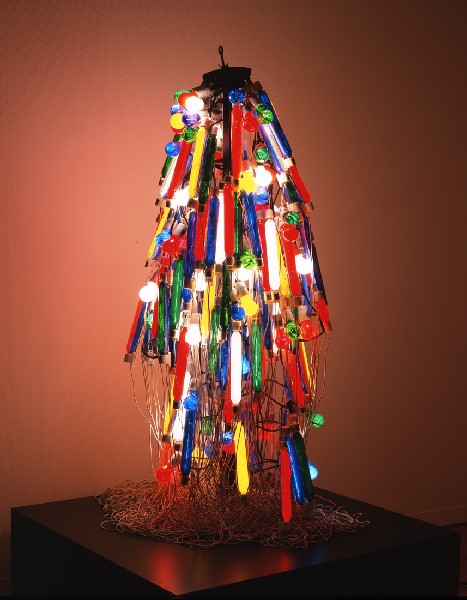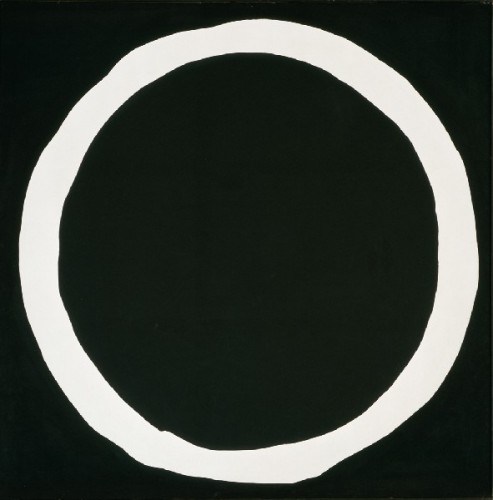Gutai: Splendid Playground, at the Guggenheim
Post War Japanese Art Feb.15 to May 8
By: Guggenheim - Dec 20, 2012
From February 15 to May 8, 2013, the Solomon R. Guggenheim Museum will present Gutai: Splendid Playground, a retrospective of the Gutai Art Association (1954–72), the radically inventive and influential Japanese artistic collective whose innovative and playful approaches to installation and performance yielded one of the most important international avant-garde movements to emerge after World War II. Based on fifteen years of research, Gutai: Splendid Playground provides a critical examination of both iconic and lesser-known examples of the collective's dynamic output over its two decade history and explores the full spectrum of Gutai’s creative production: painting, performance, installation art, sound art, experimental film, kinetic art, light art, and environment art. Gutai: Splendid Playgroundis the first North American museum exhibition devoted to the Gutai group and offers a comprehensive interpretation of the convention-defying movement.
Comprising approximately 145 works by 25 artists and spanning two generations of Gutai artists, Gutai: Spendid Playground is organized into six chronological and thematic sections presented along the Guggenheim ramps:
Play: An Uninhibited Act
Concept: Can a Piece of Cloth Be a Work of Art?
Network: To Introduce Our Works to the World
The Concrete: The Scream of Matter Itself
Performance Painting: Pictures with Time and Space
Environment: Gutai Art for the Space Age
The exhibition also includes documentary films of the group’s historic outdoor exhibitions and stage events and offers a focus on their eponymous journal as a platform for international artistic exchange. A centerpiece of Gutai: Splendid Playground is a site-specific commission of Work (Water) (1956/2011) by the late Motonaga Sadamasa. Prior to his death in 2011, Motonaga reimagined his iconic early Gutai outdoor installation, made of plastic tubes filled with colored water, for the Guggenheim rotunda.
Gutai: Splendid Playground is co-curated by Ming Tiampo, Associate Professor of Art History, Carleton University, Ottawa, and Alexandra Munroe, Samsung Senior Curator of Asian Art, Solomon R. Guggenheim Museum. Assistance was provided by Asian Art Curatorial Fellow Lyn Hsieh.
Gutai: Splendid Playground is supported in part by the Henry Luce Foundation.
Additional funding is provided by the National Endowment for the Arts, The Japan Foundation, the E. Rhodes and Leona B. Carpenter Foundation, the W.L.S. Spencer Foundation, Tokio Marine Holdings, the United States–Japan Foundation, and the Dedalus Foundation, Inc.
The Leadership Committee for Gutai: Splendid Playground is gratefully acknowledged for its support: Hauser & Wirth, Yoko Ono Lennon, Axel Vervoordt Gallery, Rachel and Jean-Pierre Lehmann, Cindy and Howard Rachofsky, Tina Kim and Jae Woong Chung, Marianne Boesky Gallery, Richard Roth, and those who wish to remain anonymous.
Exhibition Overview
The Gutai Art Association was founded in 1954 by the influential artist, teacher, and critic Yoshihara Jiro in the town of Ashiya, near Osaka. The group spanned two generations, totaling fifty-nine artists over its eighteen-year history. The name “Gutai” literally means "concreteness” and captures the direct engagement with materials its members were experimenting with around the time it began.
Against the backdrop of Japan’s World War II militarism and defeat, the American Occupation, and Japan’s postwar reconstruction as a democratic state, Yoshihara directed Gutai as an experimental environment for his protégés to explore the potential of their creative free will. Yoshihara’s call “Do what no one has done before!” pushed Gutai to break through borders between painting and performance, object and process, and between art, the ordinary public, and everyday life. He championed art making as an act of freedom, a gesture of individual spirit, a rite of destruction to create something new. Unbridled invention led the Gutai artists to experiment with new methods and materials: they painted with watering cans, remote-control toys, homemade cannons, and bare feet; made ephemeral site-specific works using the sky, water, sand, lightbulbs, and torn paper screens; and staged exhibitions in public parks, on the beach, and in bombed-out ruins. Gutai artists gained critical attention for their use of the body and for their experimentation with technology and nature.
The Gutai group grew out of both a rich local cultural context and critical engagement with international contemporaries. The local context, arising from the cosmopolitanism of the Kansai region, included prewar modernism, theater design, traditional Japanese festivals, children’s art education, and avant-garde calligraphy. The international context included Abstract Expressionism, Art Informel, Gruppe Zero, Happenings, and environment art—all movements with which Gutai intersected both at home and abroad. Gutai: Splendid Playground seeks both to examine Gutai’s aesthetic strategies in the cultural, social, and political context of postwar Japan and to further establish the group in an expanded, transnational history and critical discourse on modern art.
Gutai artists perceived early on that the canvas had become a contested arena internationally, and inspired by Yoshihara’s ethic of originality and individualism, they literally leapt through the picture plane in their search for new forms of art. During their first phase (1954–61), Gutai constructed self-expression as an assertion of the individual against the mass-conformist legacies of wartime totalitarianism. Not only did they lead by example, performing powerful acts of self-expression, but they sought to develop the autonomy of others—of their audience, the general public, and especially of children—by provoking them to think, create, and imagine for themselves. The exhibition features Tanaka Atsuko’s interactive sound-art installation Work (Bell) (1955 [refabricated 1993]), where visitors activate a cacophony of bells ringing sequentially across the Guggenheim’s Ramp 2; and “performance paintings” by Murakami Saburo, Shimamoto Shozo, and Shiraga Kazuo. For Shiraga, painting with his feet enabled an unmediated encounter with the material and a direct bodily form of artistic expression, seen in such paintings as Untitled (1957) and Wild Boar Hunting II (1963) and in his performance Challenging Mud (1955), where the artist “painted” with his entire body in a pile of grit, directly engaging with raw matter.
During the group’s second phase (1962–72), Gutai assessed and experimented with new technologies, seeking ways to counter the perceived dehumanization caused by Japan’s rapid growth and evaluating its cultural impact. The exhibition highlights artists from this later period of Gutai production, who have long been neglected in scholarship, such as Imai Norio, Imanaka Kumiko, Kikunami Joji, Matsuda Yutaka, Matsutani Takesada, Mukai Shuji, Nasaka Senkichiro, Nasaka Yuko, and Yoshida Minoru. Exploring the relationship between art, its environment, and the viewer, Gutai’s intermedia works incorporate optical illusion, light projection, and movement. Artists frequently motorized their sculptures, turning exhibition spaces into dens of screeching, pulsing, machinelike organisms. Yoshida‘s erotic machine-sculpture Bisexual Flower (1970) mines the psychedelic effects of this approach.
During the group’s lifetime, Gutai artists showed on four continents and distributed their magazine, the Gutai journal, to contacts around the world. In 1962, Yoshihara established the Gutai Pinacotheca, which became the center of the group’s activities, functioning as an exhibition space and a site for international engagement. In 1958, the Gutai group was featured in their first exhibition in the United States, at the legendary Martha Jackson Gallery in New York. It was not until 1965, however, when Gutai was included in a show at the Stedelijk Museum in Amsterdam on the Nul and Zero movements that Gutai’s role as a pioneer of intermedia experimental art was fully recognized. Long misunderstood abroad as a painting movement by virtue of the group’s 1957–65 collaborations with French Informel critic Michel Tapié, the full spectrum and historic contexts of Gutai’s highly innovative cross-genre approaches to art making within an international context have remained understudied.
Exhibition Catalogue
The exhibition is accompanied by a fully illustrated, 316-page catalogue with essays by Alexandra Munroe and Ming Tiampo and texts by Pedro Erber, Hirai Shoichi, Kato Mizuho, Judith Rodenbeck, Reiko Tomii, and Midori Yoshimoto. The book is designed by Miko McGinty, Inc.
Education and Public Programs
For complete information about the range of public programs presented in conjunction with Gutai: Splendid Playground, please visit guggenheim.org/publicprograms. Highlights include:
Guided Tours
Free with museum admission
Curator’s Eye
Mar 1, 2 pm: led by exhibition co-curator Alexandra Munroe
Mar 15, 2 pm: led by exhibition co-curator Ming Tiampo
Apr 19, 2 pm: led by curatorial fellow Lyn Hsieh
Conservator’s Eye
March 8, 2 pm: led by conservator Corey D’Augustine
Public Programs
Sanbaso: Divine Dance
Thurs, Mar 28, 2 pm and 8 pm
Fri, Mar 29, 8 pm
Renowned kyogen actor Mansai Nomura performs Japan’s oldest celebratory dance on a stage designed by artist Hiroshi Sugimoto in the museum’s iconic rotunda. Presented in conjunction with the exhibition as a tribute to Shiraga Kazuo’s 1957 performance Ultramodern Sanbaso. Co-presented with Japan Society.
$50, $40 Guggenheim and Japan Society members, $25 students for 8 pm performances. $40, $30 Guggenheim and Japan Society members, $15 students for 2 pm performance.
Concrete Escort I, II, III
Fri, Mar 22, 6 pm and 8 pm
New York–based Japanese performance artist Ei Arakawa creates a performative exhibition tour involving painters, poets, and curators gathered into a group and addressing Gutai in the present-day. Audience members will be escorted and repositioned, with an emphasis on the power dynamic within Gutai; women and men; singularity and plurality; and performance and painting.
$20, $15 members, $10 students for 6 pm performance. $25, $20 members for 8 pm performance, which includes a reception.
Gutai as Science Fiction
Tues, Mar 12, 4 pm
Bringing together scholars from diverse fields and experts in art and technology, this program will present new research on Gutai’s second phase (1962–72) in an international context. Hosted by curators Ming Tiampo and Alexandra Munroe.
$15, $10 members, free for students with RSVP.

